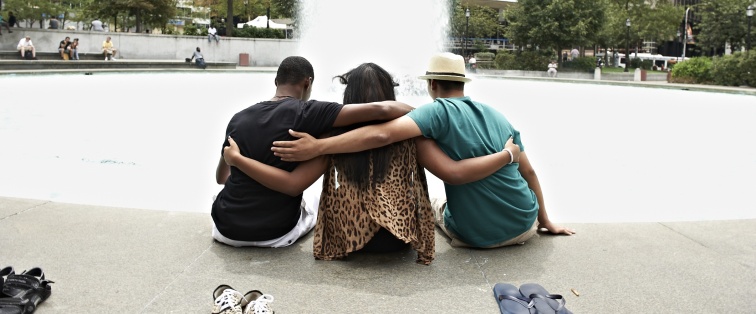Reflections on World AIDS Day and the Path Forward for our Nation’s Youth

For people living with HIV/AIDS or those of us who have devoted our careers to ending the HIV epidemic, this one day of the year to draw attention to HIV, a disease that after 30 years still kills thousands of people each day, sometimes seems inconsequential. But in the aftermath of the U.S. presidential election, this World AIDS Day has special meaning because of messages of racism, sexism, homophobia and xenophobia heard throughout the campaign. These very same forces of hate threaten the health and well-being of young people I care for who are living with and at-risk for HIV infection.
Take the case of Jonathan, a new patient to my clinic. As a 20-year-old college student, he only just had his first HIV test. He came to the U.S. on a student visa several years ago, which he was not sure was ever renewed. His first CD4 count, the strongest predictor of HIV progression, came back indicating that he had AIDS. Although he was just learning his diagnosis, HIV had already seriously weakened his immune system. We explained to Jonathan how critical it was that he start HIV medication as soon as possible. However, he doesn’t have health insurance and we worry how he will be able to get coverage because of his immigration status. He might be able to get financial and emotional support from family or friends, but he is worried that if he tells them, they will ostracize him and kick him out of the house because they will know he is gay and has HIV. Sadly, unlike other chronic diseases, HIV is one of the few, in this day and age, where the diagnosis may paradoxically lead to a loss of unconditional love and support from family and friends.
While we have made major strides in preventing and treating HIV infection globally, the disease continues to affect youth like Jonathan in unequal ways. Of the 50,000 new HIV infections in the U.S. each year, adolescents and young adults ages 13-24 account for more than one in five new infections. Of newly-infected youth living with HIV, eight of ten are young men who have sex with men, and over half are African-American. In studies of young transgender women in the U.S. nearly 25 percent have been found to be HIV-positive.
Despite these jarring statistics and recommendations for routine HIV testing by the Centers for Disease Control and Prevention (CDC), American Academy of Pediatrics (AAP) and U.S. Preventive Services Task Force (USPSTF), over 40 percent of youth in the U.S. living with HIV don’t know they are infected. Further, according to the CDC Youth Risk Behavior Survey, fewer than 25 percent of high school students who are sexually active report ever being tested for HIV.
As a pediatrician and researcher, I believe one of the first and most important steps toward ending the HIV epidemic is to assure that all youth have confidential time with their health care providers to discuss their sexual health and receive routine testing for HIV and other sexually transmitted infections (STIs).
To address this issue and rising rates of HIV and STI infections among youth in Philadelphia, in 2012 Children’s Hospital of Philadelphia (CHOP) Adolescent Initiative -in collaboration with CHOP’s PolicyLab, Public Relations, and the Office of Government Affairs, Community Relations & Advocacy - launched the iknowushould2 campaign. This theory-driven, youth-centered social media campaign has reached thousands of young people since its inception. The initial program evaluation showed that over two-thirds of youth who interacted with the campaign said they plan to get tested for STIs in the next six months.
Today, we are relaunching the iknowushould2 campaign with design updates informed by local youth, and new content including information on HIV Pre-Exposure Prophylaxis (PrEP). The newest option in the HIV prevention tool box, PrEP is a daily pill to prevent HIV infection that, if taken properly, is more effective than most vaccines. Unfortunately, despite its effectiveness, many youth still don’t know about PrEP or have many perceived and actual barriers to obtaining it. For example, in our recent study of young transgender women living with or at-risk for HIV, one-third of participants had never heard of PrEP, and several reported that they didn’t think they would be able to afford it, especially if they didn’t have access to other gender-affirming treatments such as hormones.
In reality, access to PrEP, STI testing and HIV care is very difficult for many young people if they don’t have insurance or if they want to receive free and confidential care. Even with many young people becoming newly insured under the Affordable Care Act (ACA), many adolescents and young adults still fall through the cracks and depend on funding from federal safety net programs like Title X Family Planning and Health Resources and Services Administration (HRSA) Ryan White Care Act for the most basic health care to prevent and treat HIV.
Youth need their health care providers to deliver comprehensive sexual health education and care that respects their identity, no matter their race, gender identity, immigration status or sexual orientation. I hope you will join me on this World AIDS Day, in (re)committing to programs and policies that have been proven to better the health and well-being of our nation’s youth. And we must stand up against hate that is directed at those most vulnerable in our country. Young people like Jonathan and ending the HIV epidemic depend on it.
If you are interested in learning more about the CHOP Adolescent Initiative which combines research, medical care and psychosocial support for youth living with and at risk for HIV infection, please click here. If you are interested in finding ways to support the program click here.
Acknowledgement: With thanks to Susan Lee, Dr. Sarah Wood, Matty Lehman, Dr. Marne Castillo and Isabella Lopez for their comments and feedback.
